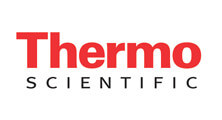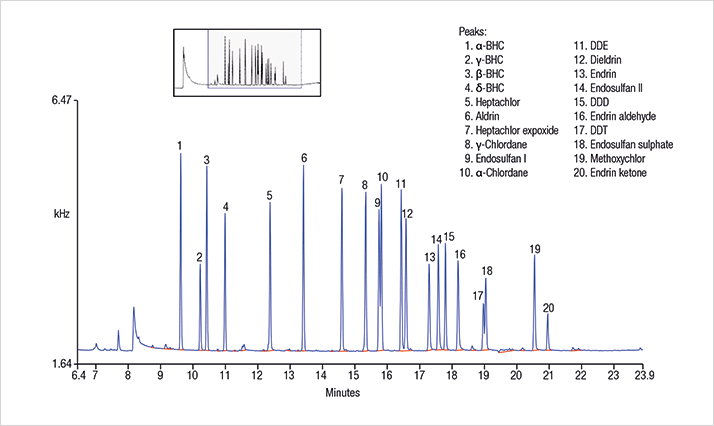Organochlorine insecticides are among the oldest and most toxic synthetic pesticides. First introduced in the 1940s, these chemicals were used extensively until most of them were banned in the 1970s and 1980s due to their health risks. Organochlorines are neurotoxic and some organochlorine compounds are suspected carcinogens.

Organochlorines, such as DDT and lindane, also persist in the environment where they are incorporated into food chains and remain for years. As such, the levels these analytes must be strictly controlled in water, soils, and other solids and various methods have been developed to detect and quantify them. The presence of chlorine atoms in their structure makes these pesticides excellent targets for an electron capture detector (ECD), a sensitive, cheaper, and easier-to-operate alternative to mass spectrometry.
The experimental method was run on a Thermo Scientific™ TRACE 1310 Gas Chromatograph used with a Thermo Scientific™ TriPlus RSH™ Autosampler and equipped with an Instant Connect Split/Splitless (SSL) injector and an Instant Connect ECD.
The experimental method follows the guidelines for U.S. EPA method 8081, with slight modifications to the GC ramp and use of a column with 0.25 μm film thickness to guarantee better separation. All other parameters are those indicated by U.S. EPA method 8081.

Separation, linearity, repeatability, and limit of detection were assessed for each compound. Good peak shape and separation were observed. Endosulfan I and α-chlordane and DDT and endosulfan sulfate tend to coelute on the stationary phase used for this application. However, good resolution was achieved with a score of 1.0 for the α-chlordane-endosulfan I pair and 0.9 for DDT-endosulfan sulphate.
Compounds were quantitated using an external calibration method and a seven-point curve. The seven-point calibration curve ranged from 0.1 to 100 ppb for each of the analytes. The limit of detection was assessed by applying the U.S. EPA guidelines, performing 14 replicate injections, calculating the standard deviation of the response, and then multiplying that value for the “t” value at 99% confidence level. These results indicate that the excellent selectivity of the ECD for chlorinated compounds makes this system is a sensitive, cheaper, and simpler alternative to mass spectrometry for assessing the presence of organochlorine residues.
TRACE 1310 GC
Inection Volume: 1µL
Liner: Splitless with glass wool (P/N 453A1925)
Carrier Gas: Helium, constant flow, 1 mL/min
Column Type: 30 m, 0.25 mm, 0.25 um, TG-5MS (P/N 26098-420)
Column Oven: Inital 100 0C, Hold 1.0 min, Ramp at 20.0 0C/min up to 180 0C, Ramp at 5.0 0C/min to 270 0C, Ramp at 20.0 0C/min to 320 0C, Hold 2.0 min.
Instant Connect SSL Injector
Inlet Temperature: 250 0C
Mode: Splitless, 2 min; split flow 50 mL/min
Instant Connect ECD
Temperature: 320 0C
Makeup Gas: N2, 15mL/min makeup flow
http://www.thermoscientific.com/en/product/trace-1310-gas-chromatograph.html





